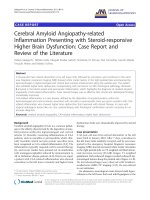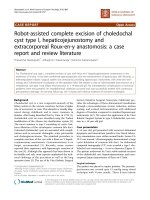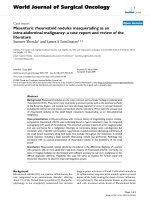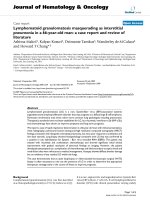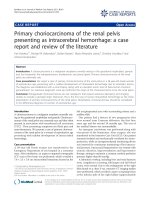Chiari malformation type 1 presenting as unilateral progressive foot drop: A case report and review of literature
Bạn đang xem bản rút gọn của tài liệu. Xem và tải ngay bản đầy đủ của tài liệu tại đây (1.42 MB, 4 trang )
Jayamanne et al. BMC Pediatrics (2018) 18:34
/>
CASE REPORT
Open Access
Chiari malformation type 1 presenting as
unilateral progressive foot drop: a case
report and review of literature
Chamara Jayamanne1,2*, Lakkumar Fernando3 and Sachith Mettananda4
Abstract
Background: Foot drop is a disabling clinical condition with multiplicity of causes, which requires detailed
evaluation to identify the exact aetiology. Here, we report an extremely rare cause of foot drop in a child, which if
not recognized early, could lead to multiple complications.
Case presentation: A 6-year-old girl presented with difficulty in walking and left sided foot droop for1-month
duration. On examination she had reduced muscle power in dorsiflexors and plantar flexors and diminished knee
and absent ankle jerk in the left side. Sensory loss was noted in L4 and L5 dermatomes on the left side. Superficial
abdominal reflex was absent on the left side while preserved in the right. Nerve conduction and electromyography
revealed nerve root or spinal cord cause for the foot drop. These results prompted ordering MRI spine and brain
which revealed Chiari malformation type-1 with holocord syrinx extending from the cervicomedullary junction to
conus medullaris.
Conclusions: This case highlights the importance of considering broad differential diagnosis for foot drop and
value of the complete neurological examination including superficial reflexes in arriving at a diagnosis. Prompt
diagnosis helped to early neurosurgical referral and intervention which is an important prognostic factor.
Keywords: Unilateral foot drop, Syringomyelia, Chiari malformation
Background
Foot drop is a disabling neurological condition which requires careful evaluation to identify the cause. Differential diagnosis for foot drop is broad however, mostly
involve disorders of the peripheral nervous system. Here,
we present an extremely rare central cause of foot drop
in a child, which if not recognized early, could lead to
multiple complications.
Case presentation
A 6-year-old girl presented with progressively worsening
difficulty in walking and left sided foot droop for1monthduration. There was no pain, paresthesia or sensory symptoms in limbs and she did not complain of
headache or backache. There was no history of trauma.
She is the second child of non-consanguineous parents
* Correspondence:
1
North Colombo Teaching Hospital, Ragama, Sri Lanka
2
Colombo, Sri Lanka
Full list of author information is available at the end of the article
and had an uncomplicated birth and perinatal period.
She was apparently well except for frequently relapsing
nephrotic syndrome for which she was on 5 mg of prednisolone and 60 mg of levimasole on alternative days.
Her last (fourth) relapse was six months ago.
On examination she was averagely built for her age.
Nervous system examination revealed wasting of anterior compartment of the left leg and reduced muscle
power in distal muscle groups on the left side - 0/5 in
dorsiflexors and 3/5 in plantar flexors. Muscle power in
proximal muscles of the left lower limb, all muscle
groups in the right lower limb and both upper limbs
were normal (5/5). Left knee jerk was diminished and
left ankle jerk and left plantar response were absent.
Sensory loss was noted in L4 and L5 dermatomes on the
left side. Superficial abdominal reflex was present on the
right side however was absent on the left side which
pointed towards a central cause for foot drop. All other
systems including blood pressure were clinically normal.
© The Author(s). 2018 Open Access This article is distributed under the terms of the Creative Commons Attribution 4.0
International License ( which permits unrestricted use, distribution, and
reproduction in any medium, provided you give appropriate credit to the original author(s) and the source, provide a link to
the Creative Commons license, and indicate if changes were made. The Creative Commons Public Domain Dedication waiver
( applies to the data made available in this article, unless otherwise stated.
Jayamanne et al. BMC Pediatrics (2018) 18:34
Page 2 of 4
Basic investigation including full blood count, erythrocyte
sedimentation rate and C-reactive protein were unremarkable and rheumatoid factor and antinuclear antibodies were
negative. Nerve conduction studies revealed normal distal
amplitude, latency and velocities in common fibular nerve
(tested at extensor digitorum brevis) in the left (amplitude
3.3 mV; latency 2.8 ms; velocity 59 m/s) and right (amplitude 2.9 mV; latency 3.1 ms) sides and tibial nerve (tested
at abductor hallucis)in the left side(amplitude 20.8 mV; latency 4.2 ms). Sural nerve sensory response was normal.
Electromyography (EMG) at left tibialis anterior revealed fibrillations and scanty motor unit potentials (MUP). EMG
of left medial gastrocnemius and right tibialis anterior were
normal. These results suggested prompt imaging of the
spine. MRI of the lumbosacral spine was arranged and was
later expanded to whole spine and brain. This revealed a
holocord syrinx extending from the cervicomedullary junction to conus medullaris (Fig. 1A and B) and Chiari malformation type 1 without bony deformities (Fig. 2).
The patient was referred to the neuro-surgical team and
is awaiting surgery which will include suboccipital craniectomy, C1 laminectomy and duroplasty decompressing
foramen magnum. Neuro-rehabilitation was commenced
and an ankle foot orthosis was offered for the foot drop.
Fig. 2 Sagittal T2-weighted MRI of cranio-vertebral junction and
cervical spine showing tonsillar herniation and central cavitary lesion
suggestive of Chiari malformation type 1 and syringomyelia
Fig. 1 a Sagittal T1-weighted sequence of MRI of thoracolumbar
spine showing hypointense central cavitary lesion involving
whole cord up to conus medullaris. b Sagittal T2-weighted
sequence of MRI of thoracolumbar spine showed central cavitary lesion
extending down to the conus medullaris.
Discussion and conclusions
Identification of the exact cause is the most important component of the management of foot drop. Causes are diverse,
consists of a broad range of pathologies however, lesions in
the peripheral nervous system which include, common
peroneal neuropathy, L5 radiculopathy, lumbosacral plexopathy, hereditary neuropathies, mononeuritis multiplex and
anterior horn cell diseases predominate. Rarely, central lesions including brain tumours and tuberculomas can cause
foot drop. In this report we have described an extremely
rare presentation of a central lesion-Chiari malformation
type 1- presenting as unilateral foot drop.
Chiari malformations refer to a spectrum of congenital
hind brain abnormalities affecting structural relationships
between the cerebellum, brain stem, the upper cervical cord
and the bony cranial base [1]. Chiari malformation type 1 is
the most common form which usually presents with
recurrent headache, neck pain, urinary frequency, and progressive lower-extremity spasticity during adolescence or
Jayamanne et al. BMC Pediatrics (2018) 18:34
Page 3 of 4
Table 1 Clinical and neurophysiological findings of previous case reports which describe syringomyelia presenting as foot drop
Panda AK et al.
[8]
Saifudheen K et McMillan HJ et al. [10]
al. [9]
Case 1
Case 2
Narry Muhn Ilya Laufer Patient
et al. [11]
et al. (Case described in
2) [12]
this case report
Age at presentation (years)
16
14
4.5
5.5
9
6
Main complaint
Rapidly
progressive right
sided foot drop
for 2 months
Rapidly
Left foot
drop for
progressive
bilateral foot
2 months
drop for 1 week
Abrupt
onset right
foot drop
Rapidly
progressive
left foot
drop
Right foot
weakness
for
1 month
Rapidly
progressive left
foot drop for
1 month
5
N/C
N/C
Normal
5
5
Muscle
Hip
power
(Affected
limb) Out of Ankle
5
Reflex
Nerve
conduction
Flexors
5
5
Extensors
5
N/C
5
N/C
Normal
5
5
Dorsiflexion
0
N/C
0
1
Weak
5
0
Plantar
flexion
3
N/C
4+
N/C
Normal
2
3
Knee
Diminished
Diminished
Normal
Absent
Absent
Absent
Diminished
Ankle
Absent
Diminished
Absent
Absent
Diminished
Diminished Absent
3 mV
Common
fibular
nerve
Tibial nerve
Electromyography
Latency
Normal
4.2 mV
5.4 mV
Normal
N/C
2.8 mV
Amplitude 2.6 ms
Low
1.5 ms
2.6 ms
low
N/C
3.3 ms
Velocity
43.1 m/s
Normal
44 m/s
45 m/s
Normal
N/C
59 m/s
Normal
Normal
Normal
Normal
Normal
N/C
Normal
Fibrillation waves
in right TA, PL,
MG, GM
Fibrillation
waves in TA,
MG
Fibrillation
waves in
right TA, PL,
MG, GM
Active
denervation
of TA
Fibrillation
waves in
TA, TP, MG
N/C
Fibrillation
waves in left
TA. Left MG
was Normal
Note: TA Tibialis Anterior, PL Peronius Longus, MG Medial Gastrocnemius, GM Gluteus Medius, TP Tibialis Posterior, N/C Not Commented
adulthood. It is characterized by displacement of cerebellar
tonsils below the level of the foramen magnum which results in impaction of the foramen magnum, compression of
the cervicomedullary junction by the herniating tonsils and
interruption of the cerebrospinal fluid (CSF) through the
region [2, 3]. Disordered CSF flow may result in syringomyelia which usually presents with ‘central cord symptoms’
- numbness followed by the development of atrophy and
weakness in the upper extremities. It can have a combination of upper motor and lower motor neuron lesion
feature [4, 5].
Our patient did not demonstrate any of the usual
presenting symptoms or signs of Chiari malformation
type 1 or syringomyelia. Instead, the only presenting
clinical features were abnormality in gait and progressive unilateral foot drop. The initial clinical examination and nerve conduction test suggested a lumbar
spine pathology however ipsilateral absence of superficial abdominal reflexes suggested a lesion at the thoracic level or above. MRI scan revealed the diagnosis
of holocord syrinx with underlying Chiari malformation type 1.
Chiari malformation type 1 and associated holocord syrinx presenting as foot drop is extremely rare and only few
case reports are found in the literature (Table 1). The limited number of patients who had presented with foot drop
demonstrates variable physical signs and has marked
diversity in neurophysiological abnormalities suggesting
variable sites of involvement.
Early diagnosis of Chiari malformation type-1 is pivotal as prognosis after the surgery depends on the extent
of the neurological deficit prior to the surgery. Our patient is awaiting surgery and has an excellent prognosis
[6, 7]. In conclusion, this case highlights the importance
of considering broad differential diagnosis for foot drop
and value of the complete neurological examination including superficial reflexes in arriving at a diagnosis.
Abbreviations
MUP: Motor unit potentials; EMG: Electromyography; CSF: Cerebrospinal fluid;
TA: Tibialis Anterior; PL: Peronius Longus; MG: Medial Gastrocnemius;
GM: Gluteus Medius; TP: Tibialis Posterior; N/C: Not Commented
Acknowledgements
I acknowledged all the persons who supported for management of this child in
our institution and during the manuscript writing specially to the radiology
department for providing the photos.
Funding
No funding.
Availability of data and materials
Data sharing is not applicable to this article as no datasets were generated
or analysed during the current study.
Authors’ contributions
All authors CJ, LF and SM contribute in managing, during the work up plan
of the patient and writing the manuscript. All authors read and approved
the manuscript before the submission.
Jayamanne et al. BMC Pediatrics (2018) 18:34
Page 4 of 4
Ethics approval and consent to participate
Not applicable.
Consent for publication
Informed written consent was taken from the parents.
Competing interests
The authors declare that they have no competing interests.
Publisher’s Note
Springer Nature remains neutral with regard to jurisdictional claims in
published maps and institutional affiliations.
Author details
1
North Colombo Teaching Hospital, Ragama, Sri Lanka. 2Colombo, Sri Lanka.
3
District General Hospital, Negombo, Sri Lanka. 4University of Kelaniya,
Kelaniya, Sri Lanka.
Received: 30 January 2017 Accepted: 29 January 2018
References
1. Greenberg MS. Chiari Malformation. In: Handbook of Neurosurgery. New
york: Thieme; 2006. p. 103–9.
2. Speer MC, George TM, Enterline DS, Franklin A, Wolpert CM, Milhorat TH. A
genetic hypothesis for Chiari I malformation with or without syringomyelia.
Neurosurg Focus. 2000;8(3):E12.
3. Boyles AL, Enterline DS, Hammock PH, Siegel DG, Slifer SH, Mehltretter L,
Gilbert JR, Hu-Lince D, Stephan D, Batzdorf U, et al. Phenotypic definition of
Chiari type I malformation coupled with high-density SNP genome screen
shows significant evidence for linkage to regions on chromosomes 9 and
15. Am J Med Genet A. 2006;140(24):2776–85.
4. Milhorat TH, Bolognese PA, Nishikawa M, McDonnell NB, Francomano CA.
Syndrome of occipitoatlantoaxial hypermobility, cranial settling, and chiari
malformation type I in patients with hereditary disorders of connective
tissue. J Neurosurg Spine. 2007;7(6):601–9.
5. Tubbs RS, Lyerly MJ, Loukas M, Shoja MM, Oakes WJ. The pediatric Chiari I
malformation: a review. Childs Nerv Syst. 2007;23(11):1239–50.
6. Greenberg JK, Yarbrough CK, Radmanesh A, Godzik J, Yu M, Jeffe DB, Smyth
MD, Park TS, Piccirillo JF, Limbrick DD. The Chiari severity index: a
preoperative grading system for Chiari malformation type 1. Neurosurgery.
2015;76(3):279–85. discussion 285
7. Pomeraniec IJ, Ksendzovsky A, Awad AJ, Fezeu F, Jane JA Jr. Natural and
surgical history of Chiari malformation type I in the pediatric population. J
Neurosurg Pediatr. 2016;17(3):343–52.
8. Panda AK, Kaur M. Rapidly progressive foot drop: an uncommon and
underappreciated cause of Chiari I malformation and holocord syrinx. BMJ
Case Rep. 2013;2013. />9. Saifudheen K, Jose J, Gafoor VA. Holocord syringomyelia presenting as
rapidly progressive foot drop. J Neurosci Rural Pract. 2011;2(2):195–6.
10. McMillan HJ, Sell E, Nzau M, Ventureyra EC. Chiari 1 malformation and
holocord syringomyelia presenting as abrupt onset foot drop. Childs Nerv
Syst. 2011;27(1):183–6.
11. Muhn N, Baker SK, Hollenberg RD, Meaney BF, Tarnopolsky MA. Syringomyelia
presenting as rapidly progressive foot drop. J Clin Neuromuscul Dis. 2002;3(3):
133–4.
12. Laufer I, Engel M, Feldstein N, Souweidane MM. Chiari malformation presenting
as a focal motor deficit. Report of two cases. J Neurosurg Pediatr. 2008;1(5):392–5.
Submit your next manuscript to BioMed Central
and we will help you at every step:
• We accept pre-submission inquiries
• Our selector tool helps you to find the most relevant journal
• We provide round the clock customer support
• Convenient online submission
• Thorough peer review
• Inclusion in PubMed and all major indexing services
• Maximum visibility for your research
Submit your manuscript at
www.biomedcentral.com/submit
